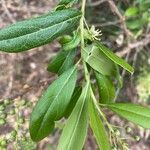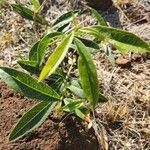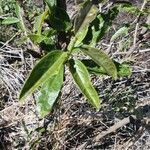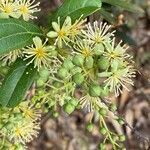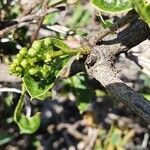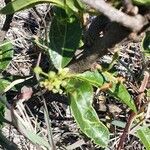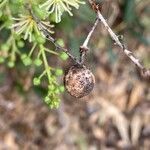Shrub or tree up to 5 m high, usually with several branches from the base. Branches spreading, often with short lateral branches. Leaves usually fascicled; lamina broadly elliptic to obovate, obtuse or rarely acute at the apex, mucronate, cuneate or abruptly rounded at the base, 4-6(-7) cm long, 1.5-2(-3) cm broad, coriaceous, slightly hairy, becoming glabrous, dark green with lighter reticulate veins; petiole 2-5 mm long, puberulous. Sclereids in the mesophyll differentiated into a foot, stalk and branched apex, reaching from both sides well into the centre of the leaf and often overlapping in the middle, single, hardly lignified, shorter but similar on the abaxial side of the leaf. Inflorescence axillary, racemose, rarely on short lateral branches, 3-7 cm long; pedicels 0.6-1(-1.2) cm long, glabrous. Bracts setaceous, 2-4 mm long, glabrous. Sepals ovate, 4-5 mm long, glabrous with papillose margins. Corona a fleshy ring, minutely denticulate. Stamens (10-)15(-22); filaments 0.8-1 cm long, glabrous. Gynophore 4-7 mm long, glabrous. Ovary ovoid, with 6 ovules; stigma capitate, sessile or nearly so. Berry spherical, 1-2 cm in diameter, glabrous, verruculous, with 2 to few seeds with pusticulate surface.
A much branched shrub or small tree. It grows 6 m tall. The young branches are smooth and yellow. The older bark is grey brown. The leaf blade is 3-8 cm long by 1.5-3.5 cm wide. It is leathery and oval. It is rounded at the base. The flowers are at the ends of branches in dense clusters. There are 20 flowers on short side stalks. Flowers are green. The fruit are round and 2 cm across. They are yellow. There is one seed. It is 7-8 mm across.
Leaf-lamina 3–8 x 1.5–3.5 cm., coriaceous, oblong, oblanceolate or obovate, apex obtuse and apiculate, cuneate or abruptly and narrowly rounded at the base, margin cartilaginous and sometimes minutely scaberulous, glabrous on both sides, midrib impressed above, prominent below, secondary nerves slightly raised below in adult leaves; petiole up to 8 mm. long, minutely pubescent on the upper side.
Inflorescences in terminal, moderately dense, c. 20-flowered racemes on short axillary branches with usually 1–2 leaves below the inflorescence on each branch; bracteoles 3–5 mm. long, subulate, trifid with the middle lobe longest; pedicels up to 1.2 cm. long, glabrous.
Shrub or tree, up to 5 m high. Leaves slightly hairy, becoming glabrous, with lighter reticulate venation visible on both surfaces. Sepals 4-6 mm long. Gyno-phore 4-8 mm long. Flowers green.
Sepals greenish, 5–7.5 x 3–4 mm., finally reflexed, narrowly ovate, acute at the apex, pubescent within and densely ciliate at the margins; receptacle granular.
Much branched shrub or small tree up to 6 m. tall; young branches glabrous and yellowish, older bark grey-brown.
Fruit globose, up to 2 cm. in diam., yellowish, glabrous, shortly apiculate at the apex.
Ovary ovoid, glabrous; stigma capitate, subsessile; ovules 12–15 on 2 placentas.
Seed usually 1, 7–8 mm. in diam., globose; testa shallowly rugose.
Stamens 15–40; filaments up to 1 cm. long, glabrous.
Gynophore up to 9 mm. long, glabrous.
